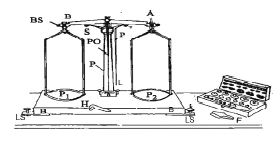Here explain some common Measuring Instruments:
Meter Scale : This simplest instrument to measure length in the laboratory is a meter scale. It’s length is 1 meter or 100 centimeters. This is why, it is called a meter scale. One side of this scale is graduated in centimeter and the other side in inches. Each centimeter is divided into ten equal parts. Each of this parts is called 1 millimeter or 0.1 centimeter. Each inch is divided into eight, ten or sixteen equal parts.
Vernier scale: In the ordinary meter scale we can measured length up to 1 millimeter. To measure fractions of millimeter like 0.2mm, 0.6mm, 0.8mm etc. we have to use vernier scale. This scale was invented by a mathematician Pierea Vernier and is called vernier scale according to his name.
Slide Calipers : The other name of slide calipers is venire calipers. Because the Venire’s method is used for the measurement with this instrument. The main scale of the slide calipers is made of a graduated rectangular still plate. A metal jaw is fixed at the starting end of the main scale, that is, at the end marked 0 of the main scale. A Jawed small scale is put over the body of the main scale, to measure fraction of the small division of the main scale accurately. It is called venire scale.
Balance : Sometimes in physics and chemistry the mass of a small quantity of a substance needs to be measured very accurately, this is not possible with a common balance. The less quantity of the substance, the more accurate the balance should be. The balance is such an accurate weighting machine. This instrument is used in physics and chemistry laboratories for accurate measurement of small masses. Because, if the measurement of the mass in the laboratory is not accurate, the result will be wrong and the objective of the experiment will not be fulfilled.

The balance has two scales pans P1 and P2 of equal weight at the two ends like an ordinary balance. The scale pans are hanged from the ends of a metal beam AB with the help of two frames of equal weight. The frames are placed on two inverted knife edges in two grooves at the end. A knife with its edges downward, is fixed in the middle of the beam AB. It is placed on a hollow vertical pillar. The pillar is firmly fixed at the middle of a wooden floor CC. Three leveling screws LS are fixed with this floor (the third has not been shown in the fig.). These are used to level the instrument. A solid metal rod inside the hollow pillar can be raised or lowered with the help of a level H connected with the floor. The base of triangular shaped agate is fixed exactly in the middle of the beam AB. The sharp age is kept on an agate plate placed on the solid rod of the beam. When the solid rod is lifted, the beam AB swings about the narrow edge of the agate as the fulcrum. The broad side of a long pointer (PO) is fixed at the middle of the balance. It’s lower narrow end is free to move over a scale. When the beam is horizontal, the pointed end of the pointer rests on the zero of the scale. The beam is made horizontal with the help of a plumb-line (PL) and the leveling screws. The entire instrument is kept in a glass box.












